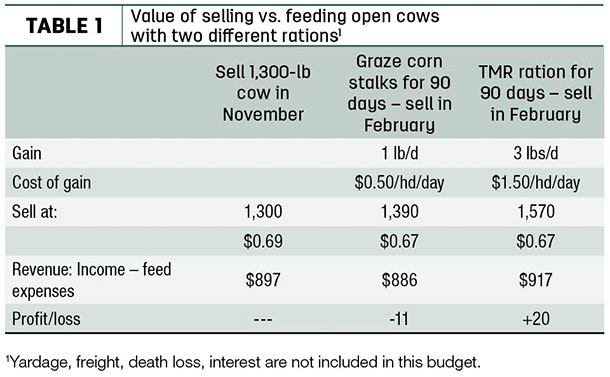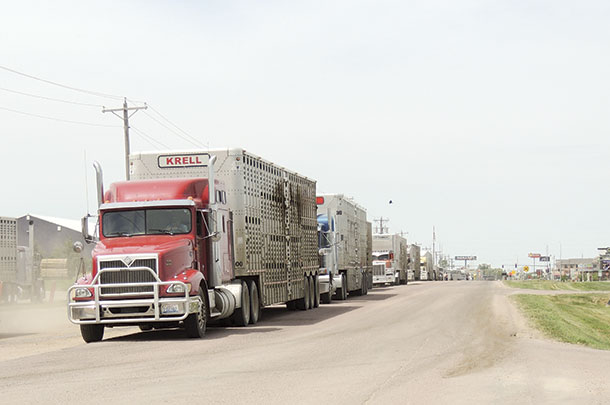The earlier open cows are identified, the more savings we have on winter feed costs in the main herd. Yet open cows don’t always mean money is lost. Yes, the cow isn’t going to wean a calf this year, but with some planning, marketing can be designed to provide extra profit from these cull cows.
The decisions to contemplate when marketing open cows include selling right away, intensively feeding for a period of time before collecting a check or potentially breeding the cow back to be placed in a fall-calving herd.
It is estimated 15 to 20 percent of the revenue in a cow-calf enterprise is generated from cull cows. In addition, according to the National Animal Health Monitoring System, 33 percent of cows are culled due to pregnancy status (failure to conceive).
Whether open cows are identified at pregnancy check or after the calving season, they usually find themselves on the first truck to town simply due to the fact they can no longer pay for their spot on the ranch.
In order for a cow to cover its costs (feed, development, fees, etc.), it needs to raise and wean a calf every year for five to six years (varies with market and feed costs). Now, some exceptions can be made for the old show heifer or foundation females, yet we can’t ignore the fact bills need to be paid, and cull cow revenue is important to cash flow.
Marketing
For spring-calving herds, open cows tend to be identified between August and December. Often, producers will sort two ways out of the chute: bred or open. If open cows are hauled to town right away, the price received may leave something to be desired. This is due to the fact the seasonal low for cull cow prices occurs between October and January.
Create a breakeven to determine if it may be more profitable to feed cows than sell today. Do this by outlining what cows are worth today, what it will cost to feed cull cows for a few months and what the cow will weigh when sold. This will give you an idea of where the price needs to be in the spring to cover the cost of feeding her and hopefully make a profit.
Breakeven
- Estimated price in November 2017 at $0.69 x 1,300 pounds = $867
- Average daily gain and feed cost: Estimated 3 pounds per day for 90 days at $1.50 per day = $135
- Estimated breakeven price in February 2018: $0.64 per pound
In order to increase profit potential, try identifying and selling cull cows before October or setting up a feeding plan for them to delay sale until after February.
Which cows to feed and feeding plans
Feeding cull cows provides an opportunity to delay marketing until prices are more favorable and add valuable weight to the carcass, increasing dressing percentage and quality grade, which directly correlates to better prices. Yet weight must be added at low cost in order to break even or realize price premiums.
Cull cows should be fed for a minimum of 50 days. In addition, not all open cows should be fed. The right kind of cows to feed are healthy cows in thin to moderate body condition score. Cows in greater body condition score (greater than 7 on a 1-9 scale) will not realize the same increase in value from feeding as thin cows and should likely be sold right away.
Likewise, any sick or unsound females should be sold to avoid risk of death loss or treatment which would induce a withdrawal time, further delaying marketing.
Feeding thin cows will reap the most benefit, as adding white fat to the carcass will directly increase yield and grade. High-grain diets convert yellow fat (result of consuming carotene in grass) to white fat, which is more desirable by the packer. When feeding high-grain diets, feed efficiency can be boosted by pairing high-energy rations with feeding technology.
Several growth-promoting technologies can be utilized when feeding cull cows in order to more efficiently convert dry matter into bodyweight. Such technologies include ionophores, implants (combination of estradiol and trenbalone acetate) or a beta-agonist. Moreover, MGA can be fed to suppress estrus expression, which expends unnecessary energy during the feeding period.
Example
Depending on the cost of feed resources and length of time on feed, price and profit margins, feeding plans can vary. The Economic Research Service July forecasts average prices in the third quarter 2017 to be $67 to $71 per hundredweight, with the first quarter of 2018 at $62 to $72 per hundredweight.
With the Economic Research Service projecting narrow profit margins for cutter cow prices going into the new year, feeding plans may need to lean on the more intensive and efficient side.
For example, Table 1 shows the difference in selling right away versus two feeding options. Grazing crop residues can be low-cost, but days on feed will be stretch on, and profit margins may be negative.

Feeding a higher-energy ration (corn, silage, byproducts) will cost more but add three times the weight and potential to return positive profits. (Prices are based on average of third-quarter 2017 and first-quarter projections 2018.)
Additional culling decisions
Along with selling open cows, other culling strategies may need to be implemented to improve profitability on the ranch and decrease winter feed usage. Second to pregnancy status, 32 percent of cows are culled due to age and teeth.

Additional culling to dispose of cows with poor udders, feet and leg conformation, body condition and disposition can create a more efficient herd with more valuable feed resources being provided to the most productive bred females. Ideally, these poor-doing cows would be sorted off before the breeding season, yet culling old or sick cows before calving time will save valuable labor and resources down the road.
Add a breeding season
If feed is in ample supply, young cows that come up open are good candidates to be enrolled in a fall breeding season. Bred females are traditionally worth more than cull cows.
Therefore, starting a fall herd can provide another source of income at a nontraditional time of year due to sales of weaned calves when markets are normally increasing. Make sure to take into consideration the additional management, pasture/feeding plans and labor required to take on a fall-calving herd in addition to a spring-calving herd before this option is chosen.
Summary
Open cows can be marketed many ways. The ultimate decision comes down to doing the homework and having a plan in place. With several areas of the Upper Midwest in severe drought this summer, feeding open and cull cows will likely not be profitable due to shortage of feed and high feed costs.
Yet each region of the country is slightly different, and it’s important to review open cow marketing plans yearly to be cognizant of where profit potential lies and not miss an opportunity to increase revenue due to lack of planning. Consult your team of ranch managers, financial advisers and local extension personnel, as always, for assistance when making plans for the future of the operation. ![]()
PHOTO 1: The seasonal low for cull cow prices occurs between October and January. Producers should evaluate whether it is more profitable to feed cows or sell today. Staff photo.
PHOTO 2: Thirty-three percent of cows are culled because they failed to conceive. Photo provided by Taylor Grussing.

-
Taylor Grussing
- Cow-Calf Field Specialist
- SDSU Extension
- Email Taylor Grussing







